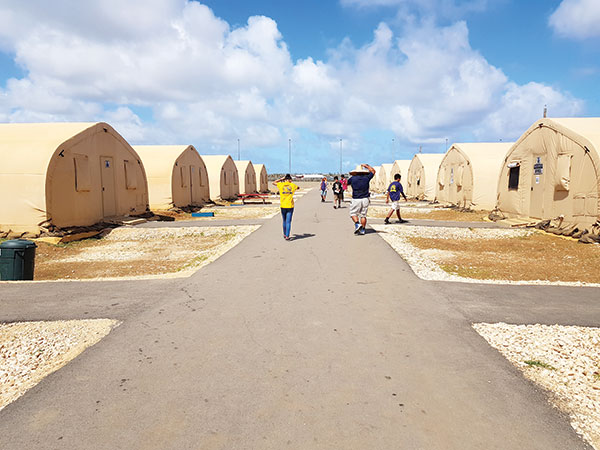School life in tents
Students walk along the pathway between tents at the temporary campus of Hopwood Middle School. (REICA RAMIREZ)

Six months after Super Typhoon Yutu pummeled Saipan and Tinian in October 2018, many students and teachers alike have slowly adjusted to a “new normal” of having classes in temporary tents and going to school in temporary campuses.
Some families actually still go home to temporary homes too—many in tents provided under the federal government’s TETRIS, or Temporary Emergency Tent and Roofing Installation Support, program.
No wonder, then, that up to now, many students and teachers are still adjusting to regain a sense of normalcy in an unfamiliar learning environment.
Hopwood Middle School principal Rizalina Liwag concedes that “it is still very challenging to adjust to the unfamiliar environment.”
She would know. Due to their campus’ extensive damage from Super Typhoon Yutu, Hopwood Middle School was forced to move out of its home campus into a temporary campus made up of about 40 “classroom tents.”
Hopwood Student Council president Kina Rangamar said that moving around, from their original temporary campus at Marianas High School, to the tents adjacent to the Koblerville Elementary School, has made the process of transitioning difficult.
“There has been a lot of power outages recently and we struggle to focus on our work with the extreme heat,” she said.
Another student, Hopwood National Junior Honor Society president MaryGrace Caras, whose house was fully destroyed by the typhoon, has been living in a tent for the past six months. She recently just moved into a new home; however, there is still no power.
Despite these challenges, Caras remain positive. “We’re really lucky that we have somewhere to be. In school, we’re surrounded by our friends that make us happy. Our teachers and counselors are always helping us have a positive school year.”
It’s not all doom and gloom, though. Liwag noted that Hopwood is doing better with their plans and goals, compared to the last few months. “It will take time to rebuild, but I have hope. Our students, teachers, and staff are very resilient to the many changes we faced this school year,” she added.
Another campus that was badly hit by the typhoon was the Northern Marianas College. A temporary campus made of several tents is located in its south field, yet it is also busy preparing for the construction of new, modern and state-of-the-art facilities to replace the buildings and facilities it lost during the typhoon.
“Despite the devastating impact by Super Typhoon Yutu on NMC facilities, the college is moving forward and continuing to provide high-quality programs and services to meet the educational needs of our community,” assured interim NMC president Frankie Eliptico.
At first, it was challenging to take online classes “when there was no power and a lot of my supplies were destroyed,” said NMC student Brianna Hunter.
However, she is glad and extremely grateful that her instructors were able to adjust their lesson plans to accommodate students in a short amount of time.
Another NMC student, Kuino Camacho, is similarly upbeat. “I’m really lucky to have a safe place to learn. Even with all the damage, the instructors prioritized the education of the students.”
Both students described the college as “an escape from all the struggles and tragedies.” NMC provided counselors and mentors to help the students adjust to the new environment. Additionally, NMC and Tan Siu Lin Foundation recently donated school supplies and laptop bags for the students, easing some of their concerns about their lost possessions.




